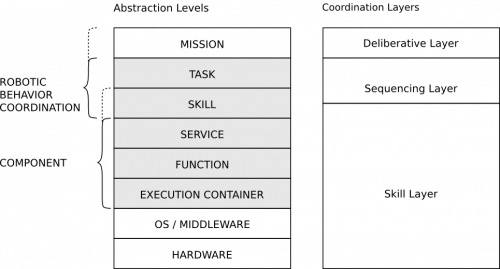User Tools
Table of Contents
Architectural Pattern for Software Components
Context
- A common way to handle system complexity is Component-Based Software Engineering
- Individual components are composable building-blocks that can be (re-)used in different applications (i.e. systems)
- Components in a system are not independent of each other but need to exchange data
- Interconnected components realize (and collaboratively execute) overall system functions (e.g. the navigation stack)
Modeling and developing a software component is the main responsibility of Component Suppliers.
This architectural pattern relates to the following abstraction levels:
- Skill (level) requires a coordination interface for each component
- Service (level) specifies interaction points to other components (i.e. the communication concern)
- Function (level) realizes the component’s internal functionality
- Execution Container (level) links functionality with the execution platform (i.e. the computation concern)
- Hardware (level) allows to directly interact with sensors and/or actuators within a component
Problem
- The overall system behavior at run-time is the result of sets of interconnected components that need to be executed in a systematic and deterministic way.
- Real-world environments are open-ended and unpredictable in nature which requires a certain adaptability and flexibility of the robot system behavior.
- System flexibility in turn requires run-time reconfigurability of individual components. Configuration options of individual components might involve design-time and run-time configurability and depend on the internal (i.e. functional) realization of a component.
- There are cases where several provided services might need to be realized in a single component (e.g. because the used library cannot be separated into several components)
- The overall role of a component is manifold:
- to realize a coherent set of provided services
- to specify dependencies to other services (provided by other components)
- to encapsulate (i.e. decouple) the functional (internal) realization of services from their general representation on system level
- to specify allowed configuration options and possible run-time modes (i.e. to be used from the skill level)
- to hide platform-related details such as communication middleware, operating system and internally used device drivers (i.e. mapping to the execution container and interacting with sensors/actuators)
Solution
The concept of a component spans across several abstraction levels:
From a functional point of view, a component spans over “Execution Container”, “Function”, “Service” and optionally also the “Skill” levels. From the robotic behavior coordination point of view, a component is on the level of robotic skills1).
A flexible component model that allows different bundlings of several provided services and that decouples the service definition from its realization within a component:
- a component can realize more than one provided service but a certain provided service is realized by exactly one distinct component
- a component should implement or use a service but not define it (service definition is a separated step)
In addition to the “regular” services a component also implements a generic configuration and coordination interface that provides access to:
- the component's life-cycle state automaton
- admissible run-time modes (i.e. activity states)
- the component's configuration parameters (i.e. allowed parameter sets)
- the coordinated dynamic wiring of component’s services (i.e. without conflicting with the component's internal functionality)
See also:
Acknowledgement
This document contains material from:
- Lutz2017 Matthias Lutz, “Model-Driven Behavior Development for Service Robotic Systems: Bridging the Gap between Software- and Behavior-Models,” 2017. (unpublished work)
http://www.robmosys.eu/wiki/general_principles:architectural_patterns:components


